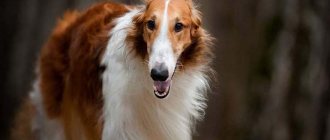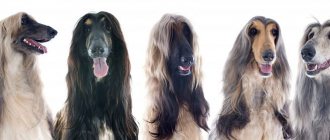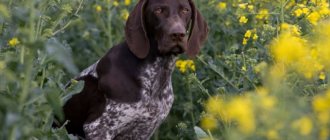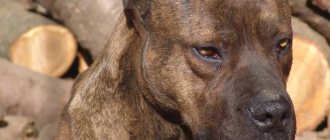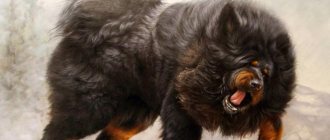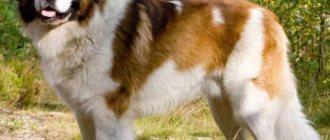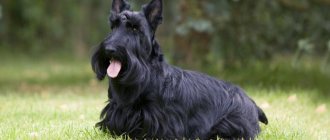Story
Russian greyhounds appeared after the Mongol-Tatar invasion. Then large and clumsy dogs, which had nothing to do with hunting, crossed with local shepherd dogs. As a result, after several decades, representatives of the breed not only acquired thick, silky hair, but also became graceful and hardy. The first representatives of the breed appeared in the 16th century in the forests of the Siberian taiga.
Such animals were especially revered in houses of noble origin. Rich families allowed themselves entire packs and raised puppies to hunt for fun. During the revolution, the breed was almost destroyed. The Bolsheviks, who considered expensive dogs a bourgeois habit, killed them in the hundreds. Breeders managed to restore the breed thanks to individuals taken abroad as gifts.
Despite such a long origin, the breed was recognized only in the middle of the 20th century. In Russia, greyhounds are used for hunting, unlike in the United States, where the animals are kept as beloved pets despite their impressive size.
Origin story
The first mentions of amazing hunters date back to the 17th century. It is assumed that the first and very successful breeder of Russian dogs was Tsar A. M. Romanov, who received a pair of greyhounds as a gift from the Zaporozhye Cossacks. The graceful animals delighted the Russian Tsar so much that he could not stay away and began breeding.
There is also a version that the breed originated in Persia and on the territory of the Kazakh Khanate during the reign of Ivan the Terrible. How it was actually not known for certain.
Starting from the 18th century, dogs were subjected to total “pumping”. They were crossed with different types of hunting greyhounds without any specific goals. Selection occurred spontaneously, which led to fragmentation of the breed and inhibition of its development. Inept work greatly affected the external characteristics of the animals and their working qualities. The followers had to restore the gene pool for a long time and, bit by bit, collect what was valuable that remained. Therefore, the first standard was adopted only in 1888.
At the beginning of the 20th century, canine breeding accelerated and by the 17th year the quality livestock numbered about 2 thousand animals. However, the Second World War made its own adjustments to the breeding and popularization of the breed. During this period, many breeders were lost, and there was no one to take care of the dogs. After the end of hostilities, Russian enthusiasts started everything from scratch.
Russian dogs came to the United States at the beginning of the 20th century, after Europe became fed up with grace and hunting talents. It is worth noting that it was in America that Russian greyhounds gained the greatest popularity and demand. They are actively used as excellent hunters, sports sprinters and elite pets.
Description
Tall dogs have an elongated body. Males are more elongated, height from 75 to 90 cm, weight - 40-60 kg. Bitches are no higher than 80 cm at the withers, weight 35-55 kg. Calm, unhurried, balanced greyhounds have an instant reaction, sharp eyesight, and develop high speed when running. While chasing prey, representatives of the species awaken their hunting instincts.
According to the standard, the description of the breed must include:
- developed muscles;
- strong bones;
- ease of movement, grace;
- silky wool.
The greyhound is strongly associated with noble hunting, which is why its image is often found on postcards and paintings.
Coat and colors
Russian greyhounds are not famous for their variety of coat colors, they do not need to show off, the main task of the breed is hunting. Colors are divided into 2 types: piebald and spotted.
There are also completely white greyhounds; this color is considered the rarest and most elegant.
The hairline, or “dog,” of Russian greyhounds is long, slightly wavy in the neck area. The hair on the hips, sideburns and head is short and dense. There is an undercoat, but not pronounced. In the area of the neck, chest and belly, the hair lies in a muff, and the hair along the paws resembles trouser legs.
Character and breed standard
The standard defining the main characteristics of the breed and blood purity:
- wedge-shaped head;
- narrow and elongated muzzle, large forehead;
- the color of the slightly bulging eyes is brown, and the cut is almond-shaped;
- the ears are set close to each other, they are small in size, triangular in shape;
- large teeth, black nose;
- the stomach is retracted, the torso is powerful, the back is narrow;
- the legs are long with strong paws and curved claws;
- slightly wavy coat in the neck area;
- sickle-shaped tail, lowered in a calm state, while hunting - straightened upright.
When evaluating at exhibitions and competitions, all of the above indicators are taken into account.
Signs of crossing with other breeds:
- short neck:
- too long coat;
- blue eyes;
- too thin massive body.
The character of greyhounds is complex, so there are often dissatisfied responses about representatives of the breed. Smart, good-natured and delicate animals require strict training and long, frequent walks. They are not prone to aggression, but the owner should not forget about the hunting instincts of the breed. Stubbornness and willfulness are the hallmarks of their character.
The purpose and character of the Russian greyhound
The main purpose of the Russian greyhound is hunting . It is used to corral any animals in open areas. The dog is distinguished by such qualities as:
- self confidence;
- calm;
- equilibrium;
- restraint.
Despite the fact that this is a hunting breed, the Russian greyhound joins the family and is rightfully considered its full member. There is no intrusiveness in her, so she can calmly not move from one place for many hours. If someone stranger comes to visit, the dog will be a little timid and will not show aggression towards such a person.
The Russian Greyhound loves affection very much . At the same time, she is aristocratically reserved. When hunting with this animal, it must be constantly kept under control, otherwise it will run away after the animal. What the consequences will be is absolutely unknown.
It is very easy to teach a dog new commands, since their intelligence is well developed . At the same time, they need to be properly taught to communicate with small children. The Russian greyhound gets along with other animals, but not always.
Sometimes the Russian Greyhound may feel irritable. This mainly manifests itself in cases where the dog is bored.
Pros and cons of the breed
Freedom-loving, stubborn greyhounds feel best in the wild; their behavior is determined by direction. Hunting animals are not designed for apartment life. Owners should not let their pet off the leash while walking in parks or squares.
A cat, a bird, a running person can provoke a greyhound to rush after it, and no command will stop it.
The dog will not get along well with other pets; friendship or at least peaceful coexistence can only be achieved through long-term training. For small children, the dog will never become a nanny, just like a watchman.
Maintenance and care of the Russian greyhound
The owner of a Russian Greyhound must follow a number of specific hygiene rules that apply to this dog. First of all, her coat should look neat. To do this, you need to take care of her every day : combing, brushing, removing dirt.
Among other things, proper care of your pet’s fur is a means of preventing the occurrence of all kinds of parasites. Most often these include scabies mites and fleas.
The Russian Greyhound feels great in a city apartment. However, she requires constant long walks . At the same time, it is vital for her to run around without a leash for some time. This is very important for her physical fitness.
Education and training
The appearance of a Russian greyhound puppy in a house or apartment brings a long process of education, training, and patience for the owner.
Expert opinion
Anna Abramenko
An avid dog lover. Experience in veterinary medicine since 2009.
Ask a Question
Proud and stubborn animals often show individuality and rebellion. They deliberately ignore commands at the moment of awakening hunting instincts.
The owner should not show aggression or excessive severity towards the pet. There is no need to expect the dog to serve. You can’t raise your voice at her and demand that she bring the slippers in her mouth. Relationships “as equals” are the key to success in communicating with a dog of this breed. The pet must accept the owner as a leader; if this does not happen, it is worth thinking about special training courses.
Features of hunting
The puppy is taught to hunt from an early age. It must be accustomed to the sounds of a special trumpet that is used to catch prey.
The owner needs to train the animal to strict restraint so that the dog does not start eating without permission and a clear command.
Previously, the breed was kept specially and hunted with them often. Now it is necessary to take care of your pet’s stamina and subject it to daily physical activity, otherwise it will lose its natural qualities and gain excess weight.
From the age of two months, the puppy is taught to respond to its name, walk on a leash, and follow basic commands. It is best to raise a child in natural field conditions. Greyhounds are trained using training, most often for a hare or fox, less often for a wolf. The young hunter is given experienced animals as an example. If the puppy is not trying to kill, but is only playing with the prey, the adult dog should teach him how to deal with the caught animal. It is important to awaken the puppy’s natural instincts.
How to choose a puppy
Those wishing to purchase a purebred puppy should contact a nursery or a trusted breeder. Do not forget that this is a future hunter, so when choosing a puppy, first of all, pay attention to its health and behavior.
The puppy should have shiny, silky fur, clear, not sour eyes, and should not flinch from loud sounds. Puppies can be taken from their mother as early as two months of age. But ideally, it is better to take a ten-month-old teenager who has received all the necessary vaccinations. At this age, he is already able to understand what is required of him during training.
Care and maintenance
Long-haired individuals require careful care of their hair. The pet must be combed at least twice a week, and during periods of shedding this should be done even more often. It is recommended to trim the fur between the toes.
Representatives of the breed are quite clean themselves, so you don’t have to bathe them often - 1 or 2 times a year, no more.
Expert opinion
Anna Abramenko
An avid dog lover. Experience in veterinary medicine since 2009.
Ask a Question
A country house with a large, spacious enclosure is best suited for keeping a greyhound. Daily walks and morning jogging with exercise are required.
In the first days of a puppy's arrival in the house, you should prepare a place for it. Place a soft bedding or mattress where there are no drafts or passageways. It is better to remove for the first time items that a new family member could spoil.
At a young age, the pet does not need long walks or training. This will harm his weak, unformed bones.
Nutrition
Large individuals need sufficient food. The diet of greyhounds requires variety and good quality. These are very expensive animals to keep.
The table shows the main products and their processing options necessary for feeding a greyhound.
| Product | How to cook | What does the dog get? |
| Meat: beef, veal, lamb, horse meat | Only horse meat can be given raw; this meat is not affected by brucellosis. It is best to boil the remaining ingredients | Protein, vitamins |
| Fish – lean varieties (cod, pollock) | The animal should be fed boiled fish, having previously cleaned it of bones. | Protein, iodine, phosphorus |
| Eggs | Boiled. An adult dog should be given no more than two eggs a week, a puppy can have 3-4 | Protein |
| Vegetables and fruits | Your pet will benefit from vegetable and light soups. Hard raw vegetables are grated on a coarse grater, seasoned with butter or sour cream | Vitamins for healthy and shiny coats |
| Milk, its derivatives | Puppies benefit from milk porridge. It is better to give fermented milk products to adult dogs. In their pure form or as an additive to other foods, they are fed kefir, fermented baked milk, yogurt, and cottage cheese. Hard unsalted cheese is suitable for feeding | Calcium |
| Cereals: rice, buckwheat, rolled oats | Steam with boiling water or hot milk | Vitamins and microelements necessary for development |
You cannot feed the animal:
- bones;
- leftovers from the table;
- salty foods;
- flour products;
- fatty meat;
- offal;
- sweets;
- starchy vegetables and fruits;
- legumes
It is recommended to feed the animal by the hour; portions should be eaten to the end.
Health and treatment
The vaccination schedule and timely deworming of the pet must be observed.
Tablets or suspensions for worms:
- piperazine adipate;
- pyrantel;
- fenbendazole;
- Praziquantel
The drugs are used both for treatment and for prevention. Infection with parasites is not dangerous for humans, but it brings suffering to the animal itself.
Greyhounds, especially at a young age, are susceptible to viral and infectious diseases that bring irreparable consequences to the body and can lead to disability.
The puppy receives the antibodies necessary to fight viruses from its mother's milk. Special serums protect the pet after weaning from its mother until the first vaccination, which should not be delayed. Repeated vaccination is carried out after changing teeth, at 7-8 months. They are given only to healthy animals with active behavior.
Expert opinion
Anna Abramenko
An avid dog lover. Experience in veterinary medicine since 2009.
Ask a Question
If the pet has lost its appetite, has purulent discharge from the eyes, extreme thirst, trembling, vomiting or diarrhea, the owner should immediately consult a veterinarian.
Selection rules
A reliable, proven, responsible breeder is the main criterion for success in acquiring a good hunting breed.
When purchasing, it is recommended to carefully study the documents and passport of the animal, its pedigree. There are no strict criteria for selection. The puppy should look healthy, strong, and active. The main thing is that it is advisable to carefully examine the baby’s skin and fur. The area around the eyes and ears should be free of mucus or pus.
Interesting Facts
- Artists and sculptors often used the image of a greyhound for their works. Louis Icart from France became famous for painting representatives of the breed and stately women, drawing figurative comparisons of grace and sophistication.
- Despite the name, pets hardly smell like dogs.
- Real hunters say about greyhounds - “Inhales the flying soul.” When the animal overtakes the game and deals with it, it seems to freeze over the carcass and falls into a stupor.
- Experts believe that the Russian breed originated from Sluggi (Arabian greyhounds).
- To hunt with such a dog you will not need a weapon. The animal will do everything itself.
- During the time of Ivan the Terrible, it was customary to give greyhounds special names that corresponded to the appearance and character of the animal: Zlata, Rada, Velichy, Ryvok, Catch-up.
- The emblem of the Russian Canine Federation features the profile of a greyhound.
History of the breed
In Rus', until the 15th century, greyhounds were not bred to help hunters. Falcons, golden eagles, and hawks were used to hunt animals and birds. Greyhounds, that is, fast, meant horses.
The fashion for greyhounds appeared in the 15th - 16th centuries. The Russian Greyhound, like no hunting dog known until then, was adapted to the climatic conditions of Russia, its copses and steppes.
The first greyhounds appeared in Rus' thanks to the Tatar-Mongols, and they adopted the skills of hunting with such dogs from the Arab and Iranian peoples. The Russian principality liked the new entertainment.
Salukis, Persian greyhounds adapted to running long distances without obstacles, began to crossbreed with Siberian huskies, as they were called bad dogs. The new breed became known as the Russian hound greyhound.
The speed that a healthy dog develops reaches 60 kilometers per hour. This certainly does not compare with the speed of the Saluki (69 km/h) and Greyhound (70 km/h) dogs. But these breeds are designed for hunting in open areas. And the greyhound runs long distances across steppe and forest-steppe landscapes.
Note! The South Russian greyhound appeared in Russia from the crossing of greyhounds living in Central Asia, Kyrgyzstan, and Crimea. And although it looks like a Russian greyhound, it has nothing to do with the Saluki breed; they have different ancestors. It is used mainly in hunting hare and fox.
Saluki breed prototype of the Russian greyhound
Reviews
Our favorite Alma is a very fast, energetic dog. It is not easy and very expensive to keep such a large hunting greyhound in an apartment, but the baby has been with us for almost 10 years. Taking care of her disciplines the whole family, because every morning we go for a long run.
It is not recommended to buy a puppy not for hunting, but for apartment living. The pet will run after every cat or bird on a walk. Obedient within the walls of a house, but completely uncontrollable within the city. It is expensive to keep an animal, since a purebred and very large dog needs a balanced diet, especially good meat.
An ideal breed for baiting a hare or fox. The dogs Duke and Musketeer have been hunting with me for more than 7 years. I bought them as puppies from a reliable nursery. The breeder provided all the necessary documents. As a result, I have excellent hunting dogs. He raised and trained himself.
Before deciding to purchase a representative of this breed, you should think carefully, analyze the facts, and discuss your decision with family members. The greyhound dog is not included in the list of aggressive animals, but still is not distinguished by its submissiveness and docile nature. Expensive to care and maintain, she requires training, education, and time for communication.
Hunting with a Russian greyhound
It is better to hunt with a greyhound among the steppes and fields. There she reaches speeds of up to 60 km per hour. The dog has keen eyesight and a keen sense of smell. The impulse of force with which he catches up with the prey and grabs the hind legs simply turns the animal over and he breaks his neck.
Note! Hunting in the forest for a greyhound is associated with the danger of crashing into a tree while chasing game. Running at high speed does not allow the dog to quickly brake and go around the obstacle. Concentrating her attention on the pursued game, she may simply not notice him.
Currently, hunting is not as popular as it used to be. In many countries it is completely prohibited. Hunting dogs are increasingly showing their skills in sports competitions called coursing, which is an imitation of hunting for game.
In the fight for the prize
Dogs can run long distances, up to 1000 meters, after mechanical bait without stopping. In hunting for artificial game, a greyhound dog demonstrates its skills and abilities in a natural environment, the judges determine whether it is suitable or not for hunting a real animal.
When purchasing a dog of this breed, you need to weigh your capabilities for long, active walks. Without them, the dog loses its working skills, gets bored and is not happy about anything.
Photo and video review
The greyhound is often confused with the Russian hound. These are different but similar breeds. The latter, according to its name, only drives the prey, while the greyhound catches and kills the caught game. Photos and videos of Russian greyhound owners will help you understand the intricacies of the breed.
Nicknames for Russian Greyhound
Nicknames are given to Russian greyhounds based on the personal characteristics of a particular dog. For example, these could be: Wind, Dexterous, Whirlwind, Nimble, Bullet, Rezva.
Since the Russian greyhound is distinguished by its fierce hatred of the animal it is pursuing, this is reflected in such nicknames as: Fierce, Tiranka.
In the old Russian lists there are many more sonorous names that you can choose for your pet. Of course, today modern nicknames are increasingly used.
